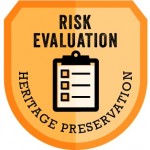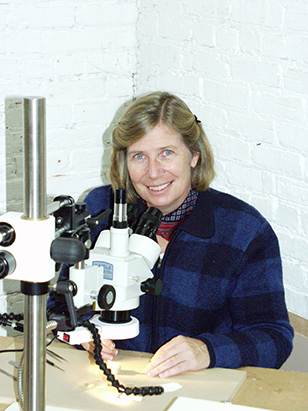 Even in times of economic hardship, cultural heritage institutions with limited staff and resources can improve the protection of people, buildings, and collections through thoughtful planning. By identifying the hazards that threaten your collections and assessing the risks they pose, you are taking the first step in disaster planning. Heritage Preservation’s Risk Evaluation and Planning Program (REPP) was featured in this course as a resource that simplifies the risk evaluation process.
Even in times of economic hardship, cultural heritage institutions with limited staff and resources can improve the protection of people, buildings, and collections through thoughtful planning. By identifying the hazards that threaten your collections and assessing the risks they pose, you are taking the first step in disaster planning. Heritage Preservation’s Risk Evaluation and Planning Program (REPP) was featured in this course as a resource that simplifies the risk evaluation process.
This course continued with Protecting Your Collections: Writing a Disaster Response Plan and is a part of the Caring for Yesterday’s Treasures—Today series.
In addition to webinar recording links below, you will also see transcripts of those recordings, resources that were compiled by the course instructor, and PowerPoint presentations.
Webinar 1: Overview: What Disaster Planning Entails
Tuesday, February 5, 2013
2:00 – 3:30 pm EST
Instructor: Alexandra Allardt
Creating a disaster plan can seem so daunting. It’s always on the to-do list, but it never quite makes it to the top. But recent events, such as Hurricane Sandy, underscore the need for a plan. This session introduced the terminology of disaster planning, the importance of establishing a relationship with your local emergency responders, and resources that can help jump-start the planning process.
CLICK HERE FOR THE WEBINAR 1 RECORDING
For closed captions, please access this via this link.
PowerPoint Presentation:
Overview: What Disaster Planning Entails
Suggested Reading and Additional Resources:
Webinar 1 Handout (contains links to resources)
REPP: Suggested Contents of a Basic Emergency Plan That Addresses Collections
(Heritage Preservation)
A Public Trust at Risk: The Heritage Health Index Report on the State of America’s Collections
(Heritage Preservation)
Planning and Preparedness Resources (Heritage Preservation)
Field Guide to Emergency Response and Emergency Response and Salvage Wheel
(FAIC)
ERS: Emergency Response and Salvage App (Heritage Preservation)
Pocket Response Plan (Council of State Archivists)
Emergency Preparedness Planning: Media Relations (The Hartford)
Talking to the Media (American Library Association)
Template Press Release (compiled by Alex Allardt)
Webinar 2: Earth, Wind, and Fire: Identifying External Hazards to Your Collections
Thursday, February 7, 2013
2:00 – 3:30 pm EST
Instructor: Alexandra Allardt
Both natural and man-made hazards in your community and your region pose a threat to your collections. How does one go about identifying the hazards that will have the greatest negative impact on people, your building(s), and your collections? Local and national resources and services are available to help you plan for emergencies. This session outlined where to find this information and how to build better relationships with local first responders and emergency management officials.
CLICK HERE FOR THE WEBINAR 2 RECORDING
For closed captions, please access this via this link.
PowerPoint Presentation:
Earth, Wind, and Fire: Identifying External Hazards to Your Collections
Suggested Reading and Additional Resources:
Webinar 2 Handout (contains links to resources)
FEMA Mobile Alert System
The National Association for Amateur Radio
Implementing the Incident Command System at the Institutional Level David Carmicheal
ICS Training Program from FEMA
Webinar 3: What Lurks Within: Identifying Hazards within Your Collections
Tuesday, February 12, 2013
2:00 – 3:30 pm EST
Instructor: Alexandra Allardt
Damage to collections is very often the result of problems with an institution’s building, systems, and/or procedures; mold and pests come to mind. But internal hazards can also be present in old treatments (arsenic, DDT), paints and solvents stored in the basement, and radioactive or wet-specimen collections. This session identified typical safety issues and threats to collections in cultural heritage institutions.
CLICK HERE FOR THE WEBINAR 3 RECORDING
For closed captions, please access this via this link.
PowerPoint Presentation:
What Lurks Within: Identifying Hazards within Your Collections
Suggested Reading and Additional Resources:
Webinar 3 Handout (contains links to resources)
Visual Materials: Processing & Cataloging Bibliography (The Library of Congress)
Hazardous Waste – Treatment, Storage & Disposal (Environmental Protection Agency)
Hantavirus (Centers for Disease Control and Prevention)
The Not-So-Mad Hatter: Occupational Hazards of Mercury (Science Connections, CAS)
Webinar 4: As Simple as 1-2-3: Ranking the Risks to Your Collections
Thursday, February 14, 2013
2:00 – 3:30 pm EST
Instructor: Alexandra Allardt
After external and internal hazards have been identified, you can establish the priorities needed to move forward with disaster planning. The REPP Prioritization Worksheet will help you rate risks based on the likelihood of their occurrence and the severity of potential damage. This session provided tips on preparedness, ideas for simple and economical mitigation measures, and suggestions on how to implement them.
CLICK HERE FOR THE WEBINAR 4 RECORDING
For closed captions, please access this via this link.
PowerPoint Presentation:
As Simple as 1-2-3: Ranking the Risks to Your Collections
Suggested Reading and Additional Resources:
Risk Evaluation and Planning Program (Heritage Preservation)
- Risk Evaluation Tool Instructions
- Risk Prioritization Worksheet
- Site Questionnaire
- Walk-through Checklist
- Site Questionnaire
- Preparedness Tips
- Mitigation Tips
- Suggested Contents of a Basic Emergency Plan That Addresses Collections
- Steps for Developing an Emergency Plan
- Resources for Emergency Planning and Preparedness (Heritage Preservation)
- Museumpests.comKnox-Box
- NOAA Watch
INSTRUCTOR

Alexandra (Alex) Allardt is Principal and Managing Director of ArtCare Resources, an independent museum consultancy firm based in Newport, Rhode Island.
After completing her academic art conservation training at the Cooperstown Graduate Program at the State University of New York, Alex headed the objects conservation laboratory at the Pacific Regional Conservation Center in Honolulu. She then relocated to head the conservation laboratory at Harvard University’s Peabody Museum of Archaeology and Ethnography.
Alex left Harvard in 1980 to start ArtCare Resources in pursuit of her passion to help small, under-resourced museums, natural science centers, historic sites, and tribal agencies problem-solve their collection preservation challenges.
In 2004 she became a certified member of the American Institute for Conservation Collections Emergency Response Team and has been teaching cultural resource emergency management since then. She hosts risk evaluation and emergency planning workshops throughout the country and facilitates table top and functional exercises to test emergency plans and institutional readiness.




